Linhuan Wu1,2, Liu Liu1,2, Qinglan Sun2, Bin Liu3, Jianrong Yu4, Ping Xu4, Fang Chen5, Yunwei Chen5, Zhenqi Li4, Huilin Shi4, Yuguang Zhou6, Juncai Ma1,2,7


1. Institute of Microbiology, Chinese Academy of Sciences, Beijing 100101, China;
2. World Data Centre for Microorganisms(WDCM), Beijing 100101, China;
3. Bureau of Science & Technology for Development, Chinese Academy of Sciences, Beijing 100864, China;
4. Shanghai Information Center for Life Sciences, Chinese Academy of Sciences, Shanghai 200031, China;
5. Chengdu Documentation and Information Center, Chinese Academy of Sciences, Chengdu 610041, Sichuan Province, China;
6. China General Microbiological Culture Collection Center, Institute of Microbiology, Chinese Academy of Sciences, Beijing 100101, China;
7. State Key Laboratory of Microbial Resources(SKLMR), Institute of Microbiology, Chinese Academy of Sciences, Beijing 100101, China
Received: 5 January 2018; Revised: 27 April 2018; Published online: 19 June 2018
Foundation item: Supported by the Strategic Priority Research Program of the Chinese Academy of Sciences (XDA19050301), by the National Key Research and Development Program of China (2017YFD400300, 2016YFB100605, 2017YFC1201202), the National Science Foundation for Young Scientists of China (31701157) and by the National R & D Infrastructure and Facility Development Program of China, "Fundamental Science Data Sharing Platform" (DKA2017-12-02-XX)
Corresponding author: Juncai Ma, Tel/Fax:+86-10-64807422;E-mail:ma@im.ac.cn.
Abstract: [Objective] Microbial resources remain a major focus of biotechnology development, because of their crucial value for fundamental life science research and for development of the bio-economy. China, as one of the two largest producers of scientific publications in the world, will play a global role in research and exploitation of microbial resources. The objective of this study was to analyze progress in microbial resource research and patenting in China to provide strategic directions for research and bio-industry.[Methods] Data were analyzed from culture collections, publications and patents to gain a picture of the status and trends in microbial resources research and exploitation in China. The data were benchmarked against those of other countries. Based on these analyses, we provide here suggestions for planning and policy to research, manage and exploit microbial resources.[Conclusion] Establishment of various microbial resource platforms in China reflects the increasing attention paid to this scientific area. The high number of publications annually and patents licensed indicate impressive progress in research and bio-industrial applications. Comprehensive resource preservation and development of research and application systems will provide a solid support for the bio-economy in China and other countries.
Keywords: microbial resourcesculture collectionresearch evaluation
中国微生物资源研究现状及未来发展态势分析
吴林寰1,2, 刘柳1,2, 孙清岚2, 刘斌3, 于建荣4, 徐萍4, 陈方5, 陈云伟5, 李祯祺4, 施慧琳4, 周宇光6, 马俊才1,2,7


1. 中国科学院微生物研究所, 北京 100101;
2. 世界微生物数据中心, 北京 100101;
3. 中国科学院科技促进发展局, 北京 100864;
4. 中国科学院上海生命科学信息中心, 上海 210031;
5. 中国科学院成都文献情报中心, 成都 610041;
6. 中国普通微生物菌种保藏中心, 北京 100101;
7. 微生物资源前期开发国家重点实验室, 北京 100101
收稿日期:2018-01-05;修改日期:2018-04-27;网络出版日期:2018-06-19
基金项目:中国科学院战略性先导专项(XDA19050301);国家重点研发计划(2017YFD400300,2016YFB100605,2017YFC1201202);国家自然科学基金青年基金(31701157);国家科技部国家科技基础条件平台项目"国家基础科学数据共享服务平台"(DKA2017-12-02-XX)
通讯作者:马俊才,Tel/Fax:+86-10-64807422;E-mail:ma@im.ac.cn.
摘要:[目的] 微生物资源由于其对于生命科学基础研究和生物经济的重要价值,一直是全球生物技术竞争的战略重点。中国目前已经成为在生命科学研究领域最有影响力的国家之一,每年发表的论文数量居全球第二位。通过微生物资源的保藏和利用的分析能够一定程度反映我国微生物研究的整体状况和进展,并进一步反映生命科学研究和生物产业的发展趋势。[方法] 本文通过分析我国微生物资源保藏、文献、专利等数据,阐述了我国微生物资源的保藏和利用现状,并同相关国家进行了比较,基于此分析,为我国微生物资源挖掘与利用提供战略方向和建议。[结论] 近年来,我国建立了微生物资源国家平台,每年发表论文数量居全球第二位,申请和授权专利数量居全球第一位,充分反映了我国微生物资源研究及其在生物产业的应用现状。我国正在形成一个微生物资源保藏、研究和应用的完整体系,为我国乃至全球的生物经济的发展提供支撑。
关键词:微生物资源保藏中心研究评价
Microbes with rich species and genetic diversity, metabolic patterns and ecological diversity are widely distributed throughout various habitats in the world. High genetic variability allows microbes to be compatible with different habitats. Microbes are an important part of ecosystems because they contribute to matter and energy circulation, evolution and maintenance of biodiversity[1]. In addition, microbes can provide solutions for most challenges that mankind faces: supporting a large population, sustainable production of energy, climate change, food safety, and human health[2-4].
Microbial resources contribute continuously to life science innovation as a result of the development of omics techniques[5-6], improvements in computational and imaging techniques, and innovations in bioinformatics tools for data analysis[7]. The discovery of Taq DNA polymerase from Thermus aquaticus in the mid-1970's enabled the development of polymerase chain reaction (PCR) technology. Today, the Taq enzyme is widely used in molecular diagnosis and DNA fingerprinting in an industry worth hundreds of millions dollars every year[8]. Escherichia coli, yeast and microalgae are widely used as model organisms in the de novo and recombinatorial design of biological parts, pathways and biosystems in synthetic biology[9-10]. The CRISPR-Cas system, which is based on the adaptive immune system in prokaryotes, is becoming one of the most widely used tools for gene editing[11].
Research and exploitation of microbial resources using modern biotechnology have given rise to a global competition in bio-resources. Microbes are estimated to account for 50% of all species on Earth. At present, only 1%-10% of microbes are known, and less than 0.1% of microbes are actually utilized. Therefore, microbial resources of industrial value may be the largest natural resource on Earth that has yet to be exploited effectively. Development and use of microbial resources is crucial to promote development of the bio-economy and to respond to global challenges[12].
With this in mind, the Genomic Encyclopedia of Bacteria and Archaea (GEBA) was initiated with the aim of large-scale discovery of novel genes and functions from microorganisms that may provide solutions for the most pressing global problems[13]. Microbiome studies about the structure and functions of the microbial community are booming. Since 2005, various microbiome initiatives have been launched, such as the Human Microbiome Project[14] and Earth Microbiome Project[15]. In 2016, the White House Office of Science and Technology Policy in the US formally launched the National Microbiome Initiative.
With the growing value of microbial resources, more than 700 culture collection centers have been established worldwide. They hold more than 2000000 strains of microorganisms, mainly bacteria and fungi, according to statistics from the World Data Centre for Microorganisms (WDCM).
The present study was performed to evaluate the level of microbial researches in China based on analysis of the numbers of microbial resource collections and microbial research outputs (papers and patents). These results from China were compared against similar data from other countries in order to place the country's current state of microbial research and bio-economy development in a global perspective. Given the high research and industrial productivity in China, its microbial resource development efforts will likely contribute substantially to the national and global bio-economy.
1 Methods Meta-data concerning microbial culture collections in China were obtained from the Culture Collections Information Worldwide (CCINFO) database, which is maintained by the WDCM. The CCINFO database provides meta-data management and publication services for culture collections. Currently CCINFO provides data on 723 culture collection centers from 75 countries and regions. These data include information on strains preserved, source of funding, staffing, quality and service capacity[16].
Data on patent strains reflect the Budapest Treaty on the International Recognition of the Deposit of Microorganisms for the Purposes of Patent Procedure[17], according to which microorganisms that are the subject of patent-related administrative or judicial procedures should be deposited in an international depositary authority (IDA). The World Intellectual Property Organization (WIPO) surveys IDAs annually and enters the results into a database as stipulated in Rule 11 of the Budapest Treaty.
Data on publications related to microbial resources were obtained from the Web of Science database. Literature searches included research articles and reviews published between 2001 and June 16, 2017 in journals from the subject areas of Microbiology, Mycology and Virology.
Patent data were obtained from the Derwent Innovations Index up to August 31, 2016. Patent data from 2006-2015 were searched with respect to specific microbial types. The search string was as follows: A12-W11L* or B04-B* or B04-C02F* or B04-F* or B04-K01V* or B04-N03* or B11-A01* or B12-K04A4* or B14-A04C* or C04-B* or C04-C02F* or C04-F* or C04-K01V* or C04-N03* or C11-A01* or C12-K04A4* or C14-A04C* or D03-F03* or D03-G02* or D05-A03A* or D05-H* or E04-B* or M25-F02*. Patent data for 2014-2015 were incomplete because of delays in patent approval, patent entry into the database and other factors.
2 Results and discussion 2.1 Current status of culture collections in China General trends in the development of culture collections in China: In 2017, CCINFO contained 35 culture collections and 199808 species from China, making the country the third in the world with respect to the total number of holdings (Table 1). The rank of China behind the US, Japan, Germany and Belgium highlights the lag in culture collection development in China.
Table 1. Top 10 countries in terms of microbial strains holdings. Data were taken from CCINFO
| Rank | Country | Total number of species | Number of culture collections | Average number of species per collection |
| 1 | USA | 261637 | 29 | 9022 |
| 2 | Japan | 254830 | 26 | 9801 |
| 3 | China | 199808 | 35 | 5709 |
| 4 | India | 194174 | 30 | 6472 |
| 5 | South Korea | 167127 | 24 | 6964 |
| 6 | Thailand | 118728 | 63 | 1885 |
| 7 | Brazil | 114514 | 78 | 1468 |
| 8 | Denmark | 102066 | 3 | 34022 |
| 9 | Belgium | 100044 | 7 | 14292 |
| 10 | Germany | 95593 | 13 | 7353 |
表选项
At the end of 2017, CCINFO contained 35 centers from China, located mainly in 13 provinces and municipalities. The locations with the largest numbers of centers were Beijing (34%), Hubei (17%), Yunnan (9%), Shandong (9%), Shanghai (6%), and Guangdong (6%). Beijing has professional culture collections as well as centers located in academic and research facilities including Tsinghua University, Peking University, and the Chinese Academy of Sciences. These results reflect the high level and volume of research activities in this region, which provide a solid support for microbial research and industrial development in the country.
China's culture collection originated in the 1950s. In 1951, the first national center for culture collection was proposed and established. In 1979, the National Microbial Culture Collection Committee and six professional culture collections were established. Culture collections developed rapidly over the next 30 years, as the importance of microbes was gradually realized. In 2003, construction began on the National Infrastructure of Microbial Resources (NIMR)[18], which is one of the first 23 National Science & Technology Infrastructures. The NIMR consists of nine national culture collections, carries out microbial resources integration and sharing services, and enables standardized arrangements in 104 leading units in different areas. The NIMR has developed standard technical procedures, operational mechanisms, management systems, a microbial resource information library, a physical library and an electronic sharing system. Because the nine national culture collections belong to different administrative departments, the collections differ in the resources preserved and services provided.
2.2 Deposit and distribution of microorganisms under patent procedures A basic tenet of patent law is that the details of a patent must be fully available to the public such that people with average skill in the field can reproduce the effect of the invention. To fulfill this requirement, a microorganism being patented must be made available to the public by a culture collection at an appropriate point in the patenting procedure.
The culture collections CGMCC and CCTCC serve as depository authorities of China with the approval of the Patent Bureau of China. They also serve as an IDA within the framework of the Budapest Treaty. The WIPO database indicates a total of 102035 patented strains from 45 centers in 24 countries. The number of strains in patent procedures has grown rapidly between 2008 and 2016. At the end of 2016, the US had the largest number of strains under patent procedure (36085 strains), followed by China (22640 strains) (Figure 1).
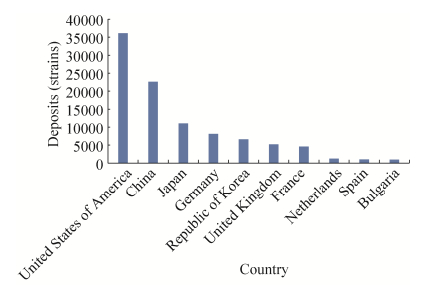 |
| Figure 1 Top 10 countries with respect to microbial materials under patent procedures, 2001-2016. |
| 图选项 |
Data from global IDAs for 2001-2016 indicate that, among the top 10 IDAs, CGMCC occupies second place (13573 strains) and CCTCC fourth place (8929 strains). These numbers lag far behind the number in the American Type Culture Collection (ATCC, 31938 strains; Figure 2). However, the number of strains under patent procedures has remained nearly the same since 2007 at IDAs outside China, whereas the number has grown rapidly in Chinese IDAs over the same period. This trend mirrors the enormous growth in the number of Chinese patents during the same period.
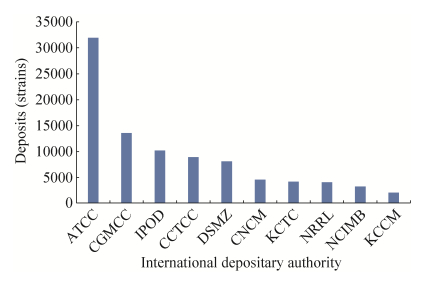 |
| Figure 2 Top 10 IDAs worldwide by number of strains under patent procedures, 2001-2016. |
| 图选项 |
In 2001-2016, global IDAs provided the public with 31090 strains under patent procedures. ATCC and the Agricultural Research Service Culture Collection (NRRL) in the United States were in first place (17975 strains) and second place (5962), while other IDAs provided fewer than 100 strains. The CGMCC (377) and CCTCC (311) in China ranked in seventh and ninth places (Figure 3). The number of strains under patent procedures in the ATCC grew continuously over the period 2001-2016. In fact, the country distributing the largest number of microbial strains under patent procedures was the United States (23937), far more than other countries. This number has increased over time. China distributed 688 strains under patent procedures, placing it in sixth position globally (Figure 4). Different countries have different regulations for distribution of biological materials under patent procedures.
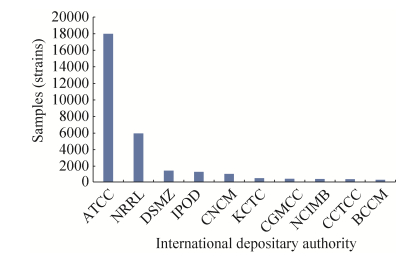 |
| Figure 3 Top 10 IDAs with respect to number of strains distributed, 2001-2016. |
| 图选项 |
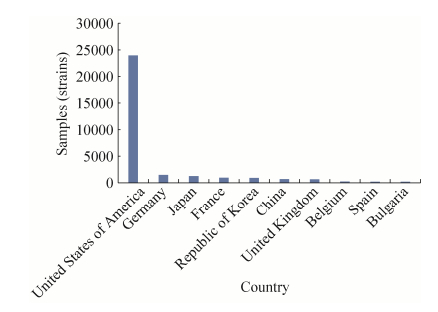 |
| Figure 4 Top 10 countries with respect to the number of strains distributed, 2001-2016. |
| 图选项 |
Patenting microbial strains is essential for biotechnology and bio-industry. The number of microbial strains under patent procedures can serve as an index of a country's level of biotechnology research and protection of intellectual property in biotechnology. Although the distribution of microbial resources under patent procedures has increased in China in recent years, it remains at a low level and does not open strains to the public sufficiently to promote life science research.
2.3 Publications related to microbial resources in China From 2001 to 2017, 726842 papers were published globally in the field of microbiology. The number of papers published annually has grown continuously over the past 17 years, from 28851 in 2001 to 53745 in 2017. This corresponds to an annual growth rate of approximately 3.96%. The top 10 countries with respect to the number of microbial resource-related publications during this period were the US, China, Germany, Japan, Britain, France, Spain, India, Canada and South Korea.
The top 5 countries showed different trends in the number of papers published annually, with China showing the fastest growth. In 2001, the United States published 9681 papers, and the average annual growth rate was 2.07%, such that in 2017, 13447 papers were published. China ranked 15th in the world in 2001, after which it rose rapidly until reaching second place in 2008, second to the US, where it has remained (Figure 5). The average annual growth rate in number of papers from 2001 to 2017 was 21.76% in China, far exceeding the world average of 3.96%. The UK and Germany showed slow growth over the same period, while Japan even showed a slight decline (Figure 6).
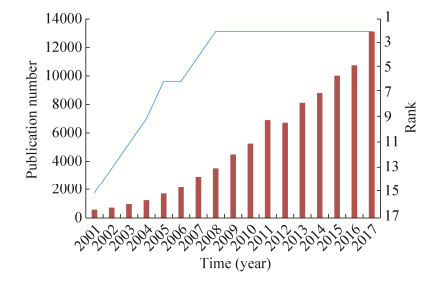 |
| Figure 5 Trends in the number of microbiology papers published annually in China, 2001-2017. The bars and lefthand scale refer to the number of papers, while the line plots and righthand scale refer to global rank. |
| 图选项 |
 |
| Figure 6 Trends in annual number of microbiology publications among the top 5 countries, 2001-2017. |
| 图选项 |
2.4 Analysis of publications related to microbial resources China has grown rapidly in life science research because of large investment in R & D. Especially in this century, the volume of microbial research in the country has grown rapidly, reflected in the number of papers. The number published in 2017 (13019) is 23-fold higher than the number in 2001 (562).
If the total number of publications can indicate the volume of research, the frequency with which those publications are cited can indicate the influence of that research. From 2001 to 2017 China was ranked second based on total number of papers in the field of microbiology; however, the total number of papers cited and the citation frequency ranked much lower in the global context (Table 2). The massive output of scientific research in China means that a certain scale and infrastructure exist, such that attention can now focus on increasing the influence of that output. In other words, science and technology development in China can shift its emphasis from quantity to quality.
Table 2. Total citation frequency of microbiology papers in top 10 countries, 2001-2017
| Rank | Country | Publication number | Times cited | Average citations per item |
| 1 | UK | 44355 | 1542492 | 34.78 |
| 2 | United States | 211437 | 7235966 | 34.22 |
| 3 | Germany | 53168 | 1591936 | 29.94 |
| 4 | Canada | 29016 | 848161 | 29.23 |
| 5 | France | 41159 | 1195547 | 29.05 |
| 6 | Spain | 32771 | 804249 | 24.54 |
| 7 | Japan | 51431 | 1021454 | 19.86 |
| 8 | India | 30517 | 475978 | 15.60 |
| 9 | South Korea | 28851 | 446820 | 15.49 |
| 10 | China | 87797 | 1190694 | 13.56 |
表选项
From 2001 to 2017, the top 20 research organizations in terms of numbers of published papers were located mostly in the US (8 organizations), followed by France (4) and Germany (2). One organization each was located in China, Brazil, Japan, Spain, Russia, and the UK. The National Science Research Center of France published 14815 papers, placing it first in the world, while the Chinese Academy of Sciences (CAS), the only Chinese institution among the global top 20, published 12666 papers, placing it in second position. The US National Institutes of Health published 11156 papers, placing it in third position. These results suggest that although China is producing an increasing number of publications per year, its organizations are still underrepresented at the global level (Table 3).
Table 3. Volume and influence of microbiology papers published by the top 10 research organizations, 2001-2017
| Rank | Organization | Publication Number | Times cited | Average citations per item |
| 1 | centre national de la recherche scientifique | 14815 | 421674 | 28.46 |
| 2 | chinese academy of sciences | 12666 | 225137 | 17.77 |
| 3 | national institutes of health | 11156 | 472023 | 42.31 |
| 4 | harvard university | 10121 | 534559 | 52.82 |
| 5 | united states department of agriculture | 9292 | 256307 | 27.58 |
| 6 | institut national de la sante et de la recherche medicale | 8908 | 274361 | 30.80 |
| 7 | university of london | 8506 | 286821 | 33.72 |
| 8 | consejo superior de investigaciones cientificas | 8470 | 224443 | 26.50 |
| 9 | institut national de la recherche agronomique | 7704 | 217956 | 28.29 |
| 10 | centers for disease control prevention | 6307 | 262763 | 41.66 |
表选项
3 China's patent output in microbial research 3.1 Analysis of patents in the field of microbiology in China From 2006 to 2015, 416749 patents were open to the public globally, and the number grew annually from 28904 in 2006 to 83355 in 2015. This corresponds to an annual growth rate of approximately 12.49%.
From 2006 to 2015, 248372 microbial patents in China were open to the public, and the annual number increased significantly from 8765 in 2006 to 58035 in 2015. This corresponds to an average annual growth rate of 23.37%, which is higher than the global average of 12.49% (Figure 7). China stands at the top of the list of 10 countries with the largest numbers of microbial patents: China, US, Japan, South Korea, Canada, Australia, India, Russia, Spain and Germany.
 |
| Figure 7 Trends in annual number of microbial patents in China, 2006 to 2015. |
| 图选项 |
The top 5 countries with respect to the total number of opened patents showed the same basic trend: the number of patents remained stable from 2006 to 2008 and declined slightly in 2009 (Figure 8). China showed a trend of rapid growth, exceeding the US in numbers of patents in 2009. South Korea remained nearly constant in the number of patents opened each year.
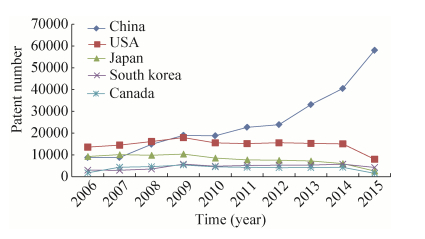 |
| Figure 8 Trends in numbers of patents announced annually in the top 5 countries, 2006 to 2015. |
| 图选项 |
3.2 Main technical fields of microbial patents in China Globally, the main technical fields of microbial patents cover the development of microbial testing equipment and application of microbial fermentation products. The number of microbial testing patents is 348639; fermentation industry patents, 334837. Important related fields include scientific instruments for microbial tests, production of food additives, production of pharmaceuticals, vaccines and cosmetics, preparation of chemical raw materials, and dairy production.
The technical fields of Chinese microbial patents show a similar distribution as microbial patents around the world. Microbial testing and the fermentation industry remain the major fields. Nevertheless, the ranking of the various fields differs slightly between China and other countries. These differences lie mainly in two categories: application of microbes to paper, detergent, oil and other fields; and production of fertilizer (Table 4).
Table 4. Top 10 technology fields of Chinese microbial patents, 2006-2015
| No. | Derwent class code | Patent technology fields | Patent number |
| 1 | B04 | Testing of microorganisms for pathogenicity | 175919 |
| 2 | D16 | Fermentation industry | 156164 |
| 3 | S03 | Scientific instrumentation | 37636 |
| 4 | D13 | Other foodstuffs and treatment | 31598 |
| 5 | A96 | Medical, dental, veterinary, cosmetic | 21488 |
| 6 | B05 | Other organics | 20409 |
| 7 | P13 | Dairy products | 14594 |
| 8 | C04 | Fertilizers | 14529 |
| 9 | A97 | Papermaking, detergents, food and oil well applications | 12899 |
| 10 | C03 | Animal feed additives | 9237 |
| The same patent may have two or more classification codes, so the number of patents corresponding to all codes may exceed the total number of patents announced. | |||
表选项
Numbers of Chinese microbial patents grew annually in the following areas: microbial testing (B04); fermentation industry (D16); instruments for microbiological testing (S03); food additives (D13); and pharmaceuticals, vaccines or cosmetics (A96). Patents for food additives began to increase strongly from 2013, pulling ahead of patents related to production of pharmaceuticals, vaccines or cosmetics. The number of patents in the fields of microbiological testing and the fermentation industry was much higher than in other areas (Figure 9).
 |
| Figure 9 Trends in the numbers of microbial patents related to different areas of technological development in China, 2006 to 2015. |
| 图选项 |
4 Conclusion and prospects 4.1 Impressive progress in microbial research in China Analysis of the latest data on collections and use of microbial resources in China indicates great progress in recent years. In 2017, CCINFO contained 35 centers from China with 199808 strains that could be shared, placing China in fourth place in the world in terms of the total number of strains collected. From 2001 to 2015, centers around the world collected a total of 102035 biological materials for patent procedures, with the CGMCC in China ranking second place with 13573 strains.
With the strong support of government and efforts of researchers, the volume as well as influence of microbial resource research has been rapidly increasing in China. From 2001 to 2017, China published 87797 papers in microbiology, and the annual number showed explosive growth, increasing 23.3 times between 2001 and 2015. The annual growth rate was 21.76%, far exceeding the world average of 3.96%. In terms of number of microbial papers, China ranked fifteenth in the world in 2001, after which its ranking rose rapidly, such that it already occupied second place behind the US in 2008, and it has remained at this position since then. At the same time, Chinese microbial papers are cited much less often than papers from other countries, suggesting lower impact despite the higher volume. The influence of Chinese papers has increased in recent years, reflecting a shift from quantity to quality as China develops its science and technology.
From 2006 to 2015, 248372 microbiological patents were opened in China, and the annual number of patents increased at an average rate of 23.37%, much higher than the global average of 12.49%. China reached the top spot in microbiology patents in 2009. Microbial patents from China distribute across technological fields in a similar way as patents from other countries. The fields most represented are microbial testing and fermentation. Patents related to food additives have grown significantly since 2013.
4.2 China should strengthen exploitation of microbial resources On September 6, 2016, China became a party to the Nagoya Protocol on Access to Genetic Resources and the Fair and Equitable Sharing of Benefits Arising from their Utilization. China has diverse ecological environments and abundant microbial resources, but it has substantial deficiencies in comparison to developed countries. These gaps include insufficient capital investment, imperfect systems of resource management and sharing, and incomplete research methods. The microbial resources remain scattered across departments and institutions, hindering follow-up research and exploitation. Effective mechanisms and a standardized platform are lacking for sharing of resources and data. As a result, much of the microbial resource wealth and diversity in China have yet to be collected, identified and preserved. Therefore, although China has made great progress in microbial resource research over the past 15 years, the country still has a long way to go in order to construct basic infrastructure, achieve breakthroughs in key research technologies, and establish chains extending from fundamental research to bio-industry. Filling these gaps would help China exploit its microbial resources to the fullest and maximize the country's contribution to its own bio-economy and to the world bio-economy, with the aim of addressing the serious challenges we face with the environment and sustainable development.
To address these issues, long-term development strategies in the field of microbial resources should be formulated and to be coordinated in the national science and technology innovation system as an essential part. Sustainable investment in the infrastructure platforms and professional talent team construction are fundament for the microbial resources researches. We also need to establish the standard system of microbial resources management and quality control, and establish the exchange, backup and sharing mechanism of microbial materials with the top-level designing and organizing to effectively promote deep mining of microbial resources. Emphasis on the microbial resources exploration and collection from specific habitats or with important application values will promote the sustainable utilization of microbial resources in healthcare, energy resources, environmental remediation and other aspects for human benefits.
Abbreviations ATCC: American Type Culture Collection; BCCM: Belgian Coordinated Collections of Microorganisms; CCINFO: Culture Collections Information Worldwide; CCTCC: China Center for Type Culture Collection; CGMCC: China General Microbiological Culture Collection Center; CNCM: Collection nationale de cultures de micro-organismes; DII: Derwent Innovations Index; DSMZ: Leibniz-Institut - Deutsche Sammlung von Mikroorganismen und Zellkulturen GmbH; GEBA: Genomic Encyclopedia of Bacteria and Archaea; IDA: International Depository Authority; IPOD: International Patent Organism Depositary; KCCM: Korean Culture Center of Microorganisms; KCTC: Korean Collection for Type Cultures; NCIMB: National Collections of Industrial, Food and Marine Bacteria; NIMR: National Infrastructure of Microbial Resources; NRRL: Agricultural Research Service Culture Collection; WDCM: World Data Centre for Microorganisms; WIPO: World Intellectual Property Organization
References
| [1] | Colwell RR. Biodiversity amongst microorganisms and its relevance. Biodiversity & Conservation, 1992, 1(4): 342-345. |
| [2] | Hayat R, Ali S, Amara U, Khalid R, Ahmed I. Soil beneficial bacteria and their role in plant growth promotion: a review. Annals of Microbiology, 2010, 60(4): 579-598. DOI:10.1007/s13213-010-0117-1 |
| [3] | Senni K, Pereira J, Gueniche F, Delbarre-Ladrat C, Sinquin C, Ratiskol J, Godeau G, Fischer AM, Helley D, Colliec-Jouault S. Marine polysaccharides: a source of bioactive molecules for cell therapy and tissue engineering. Marine Drugs, 2011, 9(9): 1664-1681. DOI:10.3390/md9091664 |
| [4] | Prakash O, Shouche Y, Jangid K, Kostka JE. Microbial cultivation and the role of microbial resource centers in the omics era. Applied Microbiology and Biotechnology, 2013, 97(1): 51-62. DOI:10.1007/s00253-012-4533-y |
| [5] | Kyrpides NC, Eloe-Fadrosh EA, Ivanova NN. Microbiome data science: understanding our microbial planet. Trends in Microbiology, 2016, 24(6): 425-427. DOI:10.1016/j.tim.2016.02.011 |
| [6] | Wang J, Jia HJ. Metagenome-wide association studies: fine-mining the microbiome. Nature Reviews Microbiology, 2016, 14(8): 508-522. DOI:10.1038/nrmicro.2016.83 |
| [7] | Antunes A, Stackebrandt E, Lima N. Fueling the bio-economy: European culture collections and microbiology education and training. Trends in Microbiology, 2016, 24(2): 77-79. DOI:10.1016/j.tim.2015.11.010 |
| [8] | Brock TD. The value of basic research: discovery of Thermus aquaticus and other extreme thermophiles. Genetics, 1997, 146(4): 1207-1210. |
| [9] | Smanski MJ, Zhou H, Claesen J, Shen B, Fischbach MA, Voigt CA. Synthetic biology to access and expand nature's chemical diversity. Nature Reviews Microbiology, 2016, 14(3): 135-149. DOI:10.1038/nrmicro.2015.24 |
| [10] | Hlavova M, Turoczy Z, Bisova K. Improving microalgae for biotechnology-From genetics to synthetic biology. Biotechnology Advances, 2015, 33(6): 1194-203. DOI:10.1016/j.biotechadv.2015.01.009 |
| [11] | Makarova KS, Wolf YI, Alkhnbashi OS, Costa F, Shah SA, Saunders SJ, Barrangou R, Brouns SJJ, Charpentier E, Haft DH, Horvath P, Moineau S, Mojica FJM, Terns RM, Terns MP, White MF, Yakunin AF, Garrett RA, van der Oost J, Backofen R, Koonin EV. An updated evolutionary classification of CRISPR-Cas systems. Nature Reviews Microbiology, 2015, 13(11): 722-736. DOI:10.1038/nrmicro3569 |
| [12] | Smith D, McCluskey K, Stackebrandt E. Investment into the future of microbial resources: culture collection funding models and BRC business plans for biological resource centres. SpringerPlus, 2014, 3: 81. DOI:10.1186/2193-1801-3-81 |
| [13] | Mukherjee S, Seshadri R, Varghese NJ, Eloe-Fadrosh EA, Meier-Kolthoff JP, G?ker M, Coates RC, Hadjithomas M, Pavlopoulos GA, Paez-Espino D, Yoshikuni Y, Visel A, Whitman WB, Garrity GM, Eisen JA, Hugenholtz P, Pati A, Ivanova NN, Woyke T, Klenk HP, Kyrpides NC. 1, 003 reference genomes of bacterial and archaeal isolates expand coverage of the tree of life. Nature Biotechnology, 2017, 35(7): 676-683. DOI:10.1038/nbt.3886 |
| [14] | Human Microbiome Project Consortium. A framework for human microbiome Research. Nature, 2012, 486(7402): 215-221. DOI:10.1038/nature11209 |
| [15] | Gilbert JA, Jansson JK, Knight R. The Earth Microbiome project: successes and Aspirations. BMC Biology, 2014, 12: 69. DOI:10.1186/s12915-014-0069-1 |
| [16] | CCINFO (Culture Collection Information Worldwide). http://www.wfcc.info/ccinfo/. |
| [17] | WIPO. Budapest - the international microorganism deposit System. http://www.wipo.int/budapest/en/ |
| [18] | NIMR. National Infrastructure of Microbial Resources. http://www.nimr.org.cn/indexAction.action |
